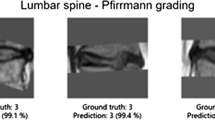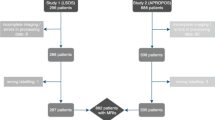Abstract
As the cognition of spine develops, deep learning (DL) emerges as a powerful tool with tremendous potential for advancing research in this field. To provide a comprehensive overview of DL-spine research, our study utilized bibliometric and visual methods to retrieve relevant articles from the Web of Science database. VOSviewer and CiteSpace were primarily used for literature measurement and knowledge graph analysis. A total of 273 studies focusing on deep learning in the spine, with a combined total of 2302 citations, were retrieved. Additionally, the overall number of articles published on this topic demonstrated a continuous upward trend. China was the country with the highest number of publications, whereas the USA had the most citations. The two most prominent journals were “European Spine Journal” and “Medical Image Analysis,” and the most involved research area was Radiology Nuclear Medicine Medical Imaging. VOSviewer identified three visually distinct clusters: “segmentation,” “area,” and “neural network.” Meanwhile, CiteSpace highlighted “magnetic resonance image” and “lumbar” as the keywords with the longest usage, and “agreement” and “automated detection” as the most commonly used keywords. Although the application of DL in spine is still in its infancy, its future is promising. Intercontinental cooperation, extensive application, and more interpretable algorithms will invigorate DL in the field of spine.








Similar content being viewed by others
Data availability
All data are fully available without restriction.
References
Rupp TK, Ehlers W, Karajan N, Günther M, Schmitt S (2015) A forward dynamics simulation of human lumbar spine flexion predicting the load sharing of intervertebral discs, ligaments, and muscles. Biomech Model Mechanobiol 14(5):1081–1105
Fehlings MG, Tetreault L, Nater A, Choma T, Harrop J, Mroz T, Santaguida C, Smith JS (2015) The aging of the global population: the changing epidemiology of disease and spinal disorders. Neurosurgery 77(Suppl 4):S1–S5
Oei MW, Evens AL, Bhatt AA, Garner HW (2022) Imaging of the aging spine. Radiol Clin North Am 60(4):629–640
Lacout A, Lebreton C, Mompoint D, Mokhtari S, Vallée CA, Carlier RY (2009) CT and MRI of spinal neuroarthropathy. AJR Am J Roentgenol 193(6):W505–W514
Kochanski RB, Lombardi JM, Laratta JL, Lehman RA, O'Toole JE (2019) Image-guided navigation and robotics in spine surgery. Neurosurgery 84(6):1179–1189
LeCun Y, Bengio Y, Hinton G (2015) Deep learning. Nature 521(7553):436–444
Deo RC (2015) Machine learning in medicine. Circulation 132(20):1920–1930
Choi RY, Coyner AS, Kalpathy-Cramer J, Chiang MF, Campbell JP (2020) Introduction to machine learning, neural networks, and deep learning. Transl Vis Sci Technol 9(2):14
Esteva A, Robicquet A, Ramsundar B, Kuleshov V, DePristo M, Chou K, Cui C, Corrado G, Thrun S, Dean J (2019) A guide to deep learning in healthcare. Nat Med 25(1):24–29
Chan HP, Samala RK, Hadjiiski LM, Zhou C (2020) Deep learning in medical image analysis. Adv Exp Med Biol 1213:3–21
Zou J, Huss M, Abid A, Mohammadi P, Torkamani A, Telenti A (2019) A primer on deep learning in genomics. Nat Genet 51(1):12–18
Duan H, Wang P, Huang Y, Xu G, Wei W, Shen X (2021) Robotics dexterous grasping: the methods based on point cloud and deep learning. Front Neurorobot 15:658280
Hallinan J, Zhu L, Yang K, Makmur A, Algazwi DAR, Thian YL, Lau S, Choo YS, Eide SE, Yap QV et al (2021) Deep learning model for automated detection and classification of central canal, lateral recess, and neural foraminal stenosis at lumbar spine MRI. Radiology 300(1):130–138
Yeh YC, Weng CH, Huang YJ, Fu CJ, Tsai TT, Yeh CY (2021) Deep learning approach for automatic landmark detection and alignment analysis in whole-spine lateral radiographs. Sci Rep 11(1):7618
Goedmakers CMW, Lak AM, Duey AH, Senko AW, Arnaout O, Groff MW, Smith TR, Vleggeert-Lankamp CLA, Zaidi HA, Rana A et al (2021) Deep learning for adjacent segment disease at preoperative MRI for cervical radiculopathy. Radiology 301(3):664–671
Qu B, Cao J, Qian C, Wu J, Lin J, Wang L, Ou-Yang L, Chen Y, Yan L, Hong Q et al (2022) Current development and prospects of deep learning in spine image analysis: a literature review. Quant Imaging Med Surg 12(6):3454–3479
Liu C, Yu R, Zhang J, Wei S, Xue F, Guo Y, He P, Shang L, Dong W (2022) Research hotspot and trend analysis in the diagnosis of inflammatory bowel disease: a machine learning bibliometric analysis from 2012 to 2021. Front Immunol 13:972079
Zhao J, Lu Y, Qian Y, Luo Y, Yang W (2022) Emerging trends and research foci in artificial intelligence for retinal diseases: bibliometric and visualization study. J Med Internet Res 24(6):e37532
Xia D, Chen G, Wu K, Yu M, Zhang Z, Lu Y, Xu L, Wang Y (2022) Research progress and hotspot of the artificial intelligence application in the ultrasound during 2011-2021: a bibliometric analysis. Front Public Health 10:990708
Stout NL, Alfano CM, Belter CW, Nitkin R, Cernich A, Lohmann Siegel K, Chan L (2018) A bibliometric analysis of the landscape of cancer rehabilitation research (1992-2016). J Natl Cancer Inst 110(8):815–824
Waqas A, Salminen J, Jung SG, Almerekhi H, Jansen BJ (2019) Mapping online hate: a scientometric analysis on research trends and hotspots in research on online hate. PLoS One 14(9):e0222194
Hirsch JE (2007) Does the H index have predictive power? Proc Natl Acad Sci U S A 104(49):19193–19198
Roldan-Valadez E, Salazar-Ruiz SY, Ibarra-Contreras R, Rios C (2019) Current concepts on bibliometrics: a brief review about impact factor, Eigenfactor score, CiteScore, SCImago Journal Rank, Source-Normalised Impact per Paper, H-index, and alternative metrics. Ir J Med Sci 188(3):939–951
Yu Y, Li Y, Zhang Z, Gu Z, Zhong H, Zha Q, Yang L, Zhu C, Chen E (2020) A bibliometric analysis using VOSviewer of publications on COVID-19. Ann Transl Med 8(13):816
Luo H, Cai Z, Huang Y, Song J, Ma Q, Yang X, Song Y (2021) Study on pain catastrophizing from 2010 to 2020: a bibliometric analysis via CiteSpace. Front Psychol 12:759347
Hinton GE, Osindero S, Teh YW (2006) A fast learning algorithm for deep belief nets. Neural Comput 18(7):1527–1554
Deng H, Qiao H, Dai Q, Ma C (2021) Deep learning in photoacoustic imaging: a review. J Biomed Opt 26(4)
Rezaeilouyeh H, Mollahosseini A, Mahoor MH (2016) Microscopic medical image classification framework via deep learning and shearlet transform. J Med Imaging (Bellingham) 3(4):044501
Kokabu T, Kanai S, Kawakami N, Uno K, Kotani T, Suzuki T, Tachi H, Abe Y, Iwasaki N, Sudo H (2021) An algorithm for using deep learning convolutional neural networks with three dimensional depth sensor imaging in scoliosis detection. Spine J 21(6):980–987
Tsai JY, Hung IY, Guo YL, Jan YK, Lin CY, Shih TT, Chen BB, Lung CW (2021) Lumbar disc herniation automatic detection in magnetic resonance imaging based on deep learning. Front Bioeng Biotechnol 9:708137
Lemay A, Gros C, Zhuo Z, Zhang J, Duan Y, Cohen-Adad J, Liu Y (2021) Automatic multiclass intramedullary spinal cord tumor segmentation on MRI with deep learning. Neuroimage Clin 31:102766
Saravi B, Zink A, Ülkümen S, Couillard-Despres S, Hassel F, Lang G (2022) Performance of artificial intelligence-based algorithms to predict prolonged length of stay after lumbar decompression surgery. J Clin Med 11(14)
Yagi M, Hosogane N, Fujita N, Okada E, Tsuji O, Nagoshi N, Asazuma T, Tsuji T, Nakamura M, Matsumoto M et al (2019) Predictive model for major complications 2 years after corrective spine surgery for adult spinal deformity. Eur Spine J 28(1):180–187
de Jonge MC, Kramer J (2014) Spine and sport. Semin Musculoskelet Radiol 18(3):246–264
Lessmann N, van Ginneken B, de Jong PA, Išgum I (2019) Iterative fully convolutional neural networks for automatic vertebra segmentation and identification. Med Image Anal 53:142–155
Li X, Dou Q, Chen H, Fu CW, Qi X, Belavý DL, Armbrecht G, Felsenberg D, Zheng G, Heng PA (2018) 3D multi-scale FCN with random modality voxel dropout learning for intervertebral disc localization and segmentation from multi-modality MR images. Med Image Anal 45:41–54
Horng MH, Kuok CP, Fu MJ, Lin CJ, Sun YN (2019) Cobb angle measurement of spine from X-ray images using convolutional neural network. Comput Math Methods Med 2019:6357171
Al Arif S, Knapp K, Slabaugh G (2018) Fully automatic cervical vertebrae segmentation framework for X-ray images. Comput Methods Programs Biomed 157:95–111
Galbusera F, Niemeyer F, Wilke HJ, Bassani T, Casaroli G, Anania C, Costa F, Brayda-Bruno M, Sconfienza LM (2019) Fully automated radiological analysis of spinal disorders and deformities: a deep learning approach. Eur Spine J 28(5):951–960
Orbach J (1962) Principles of neurodynamics. perceptrons and the theory of brain mechanisms. Archives of General Psychiatry 7(3):218–219
Anwar SM, Majid M, Qayyum A, Awais M, Alnowami M, Khan MK (2018) Medical image analysis using convolutional neural networks: a review. J Med Syst 42(11):226
Wang L, Du J, Gholipour A, Zhu H, He Z, Jia Y (2021) 3D dense convolutional neural network for fast and accurate single MR image super-resolution. Comput Med Imaging Graph 93:101973
Liu D, Jia Z, Jin M, Liu Q, Liao Z, Zhong J, Ye H, Chen G (2020) Cardiac magnetic resonance image segmentation based on convolutional neural network. Comput Methods Programs Biomed 197:105755
Zhou Y, Liu Y, Chen Q, Gu G, Sui X (2019) Automatic lumbar MRI detection and identification based on deep learning. J Digit Imaging 32(3):513–520
Lim DSW, Makmur A, Zhu L, Zhang W, Cheng AJL, Sia DSY, Eide SE, Ong HY, Jagmohan P, Tan WC et al (2022) Improved productivity using deep learning-assisted reporting for lumbar spine MRI. Radiology 305(1):160–166
Natalia F, Young JC, Afriliana N, Meidia H, Yunus RE, Sudirman S (2022) Automated selection of mid-height intervertebral disc slice in traverse lumbar spine MRI using a combination of deep learning feature and machine learning classifier. PLoS One 17(1):e0261659
Gao KT, Tibrewala R, Hess M, Bharadwaj UU, Inamdar G, Link TM, Chin CT, Pedoia V, Majumdar S (2022) Automatic detection and voxel-wise mapping of lumbar spine Modic changes with deep learning. JOR Spine 5(2):e1204
Hsieh CI, Zheng K, Lin C, Mei L, Lu L, Li W, Chen FP, Wang Y, Zhou X, Wang F et al (2021) Automated bone mineral density prediction and fracture risk assessment using plain radiographs via deep learning. Nat Commun 12(1):5472
Suri A, Jones BC, Ng G, Anabaraonye N, Beyrer P, Domi A, Choi G, Tang S, Terry A, Leichner T et al (2021) A deep learning system for automated, multi-modality 2D segmentation of vertebral bodies and intervertebral discs. Bone 149:115972
Ha J, Park T, Kim HK, Shin Y, Ko Y, Kim DW, Sung YS, Lee J, Ham SJ, Khang S et al (2021) Development of a fully automatic deep learning system for L3 selection and body composition assessment on computed tomography. Sci Rep 11(1):21656
Funding
This research was funded by the National Natural Science Foundation of China (81701199) of Ming Li.
Author information
Authors and Affiliations
Contributions
Conceptualization, DM.X. and K.C.; methodology, XY.L; software, S.W.; validation, ZK.L. and X.Z.; formal analysis, M.L.; investigation, M.L.; resources, X.Z.; data curation, DM.X.; writing—original draft preparation, K.C.; writing—review and editing, DM.X.; visualization, X.Z.; supervision, ZK.L.; project administration, X.Z.; funding acquisition, M.L. All authors have read and agreed to the published version of the manuscript.
Corresponding authors
Ethics declarations
Conflict of interest
The authors declare no competing interests.
Additional information
Publisher’s note
Springer Nature remains neutral with regard to jurisdictional claims in published maps and institutional affiliations.
Supplementary information
Rights and permissions
Springer Nature or its licensor (e.g. a society or other partner) holds exclusive rights to this article under a publishing agreement with the author(s) or other rightsholder(s); author self-archiving of the accepted manuscript version of this article is solely governed by the terms of such publishing agreement and applicable law.
About this article
Cite this article
Chen, K., Zhai, X., Wang, S. et al. Emerging trends and research foci of deep learning in spine: bibliometric and visualization study. Neurosurg Rev 46, 81 (2023). https://doi.org/10.1007/s10143-023-01987-5
Received:
Revised:
Accepted:
Published:
DOI: https://doi.org/10.1007/s10143-023-01987-5




